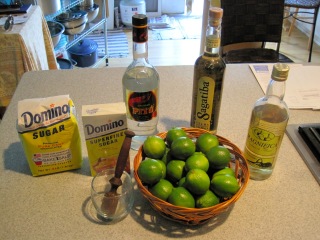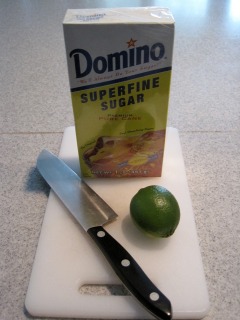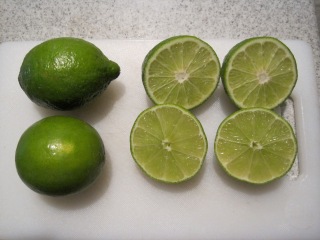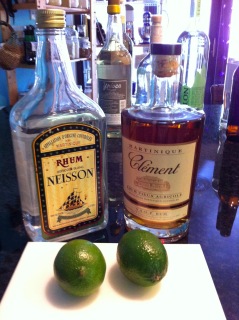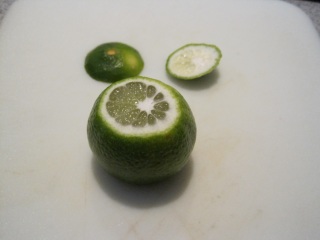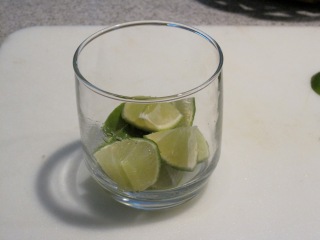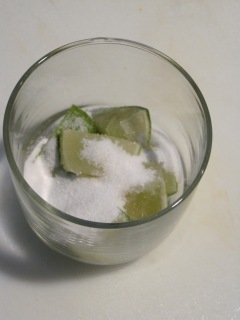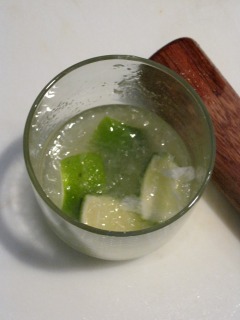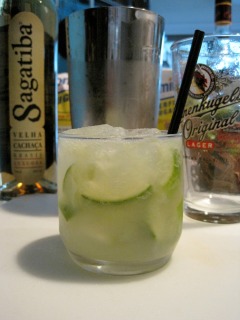MAKING THE TRADITIONAL CAIPIRINHA
Contributed by on Jul 12, 2013
One reader loves this post.
Since Americans were introduced to Cachaça (ka-sha-sa) over the last 15 years in the form of the Caipirinha (Kai-pee-reen-ya) and the many new cachaças that have been marketed here, there has been a little confusion with the proper method of making one, and even from some of the best bartenders around the country.
First and foremost, there are 4 things that always go into a Caipirinha in Brasil. Lime, white superfine sugar, un-aged cachaça and ice. It should be shaken. You can use simple syrup but it absolutely must be at least 2-1 rich syrup. Superfine or “Bar” sugar is the best choice. This kind of sugar acts to macerate the lime and extract the lime oils as well as dissolve easier than regular American table sugar. Once you understand the traditional method, you can then understand and do riffs on this basic theme
I’ve spent many years traveling or living in Brasil and have seen Caipirinhas made from Rio to Recife and from beach to bar. There are always some subtle differences to each person making one but there are some subtle common denominators to making the classic Caipirinha like a Brazilian that everyone in Brasil does.
On a beach it will most likely be made in a makeshift plastic container/shaker and served in a plastic cup.
But in a bar it will more likely be served in a small rocks glass.
The proportions will vary depending on the size of the cup or glass. We will be using an 8 oz rocks glass in the demonstration here.
I will only be giving rough quantities for the drink, they will vary according to glass since that is generally the way you regulate quantities….and it is a good way to get a feeling for making this without measuring tools…the natural or every day way!
An 8 oz rocks glass is perfect for 1 small cut up lime and one heaping tablespoon of fine sugar, ice and filled the rest of the way with cachaça. Let’s talk about sugar first.
The table sugar in Brasil is comparable to super fine, or “bar sugar” in the US. It melts and mixes easily. “Bar sugar” is kind of a lost item in American bars these days with the prevalent use of simple syrup that has taken its place. Regular table sugar in the US is a bit too coarse for making cocktails, and there is a real lack of general knowledge of bar sugar hence the reliance on simple syrup in cocktails here in the States. American table sugar grinds up what you want to muddle too much, and is also not nearly as soluble as the fine sugar.
I’ve seen many recipes that use brown or raw sugar. Brown or raw sugar are almost non-existent in Brasil and, although they make a rich Caipirinha and seem rustic, neither are or should be used in making a classic one.
Brasilians like things sweet. I like balance, but it’s all in the eye of the beholder. Adjust sweetness and tartness to your own taste, but be careful your adjustments overflow and imbalance the spirits.
Let’s talk about limes now.
Regular Persian limes in Brasil tend to be smaller than in the US where they sometimes get as big as lemons. That large size can throw off your Caipirinha if you use a whole giant one in a small glass. So try to purchase medium to small limes. Always adjust to the size of glass. If you have a giant lime, use only half of it or 3/4 of it. You will have to use your own judgement here. It’s easy.
When buying limes, choose ones that are rounder and have smooth, thin skins, with hardly any dimples. These limes are juicier and give up their juice easier, there is less pith and less bitterness. The more elongated limes with dimpled skin tend to have very thick skins and interiors. They feel hard. This means less juice and makes the limes more difficult to juice as well. A few trips to the grocer and you will be able to verify the difference easily.
Notice the two limes pictured above. The top lime is elongated and dimpled. Inside the pith and skin are much more dominant, making the lime harder and less juicy. The one on the bottom is nearly spherical, and inside the pith and skin is hardly noticeable. It is full of juice.
Cachaça is made from sugar cane. It is a style of rum called rhum agricole. The most recognizable rum to most Americans is rhum industriale. Bacardi, Myer’s, Appleton Estate, Mount Gay etc..are all this style. The difference between them is that rhum industriale is distilled from molasses, a byproduct of sugar making, and rhum agricole is made from fermented cane juice. The flavors are completely different. In the French Carribbean, rhum agricole is used in a cocktail similar to the Caipirinha, Ti Punch, which is lime juice, cane syrup and rhum agricole.
There are many cachaças in the US market today. Some are old standards from the large industrial distilleries in Brasil like “51”, Pitu, and Velho Barreiro. There are also many home distilled or artisanal cachaças made all over Brasil that may have nothing more than a hand written label. There are also some larger artisanal brands of cachaça being produced now such as Novo Fogo and Sagatiba that are really bringin the level of taste and quality to new heights.
Finally we have the cachaças made for the US or international markets such as Cabana and Leblon. If you are at a beach or barzinho (bar-zeen-yo) or botequim (bo-che-keen) in Rio, you will almost assuredly get one of the big national brands like “51” in your caiprinha. But there are bars in Brasil where you can get amazing cocktails and caipirinhas or riffs on caipirinhas made with a huge array of different cachaças; aged, flavored, from different regions and in different styles..etc..
This drink is always made with cracked or chunks of ice. Clear bag ice from the grocery store is perfect. If you are using something like Kold Draft large format ice, then you will have to crack it. It is important that the ice melts some with the drink. The drink is muddled and built in the glass, then shaken and poured back into the glass or cup. It is important that your glass be FILLED with ice. This brings the temperature down fast with the perfect amount of melt and regulates the amount of spirits to top off the glass..
Wooden muddler
Cachaça to fill glass
I prefer NOVO FOGO Cachaça
HOW TO CUT YOUR LIME FOR MUDDLING
This is a detailed step and almost always never done in the US. It really does make a big difference in taste, appearance and ease of muddling.
Cut the lime lengthwise into quarters
Cut the center white rib out of each quarter
Cut the pieces into eighths
Add to glass
Add sugar to taste (2 regular spoons or a big tblspn)
Muddle until sugar is dissolved and all juice extracted
Fill glass with ice
Fill glass with cachaça

